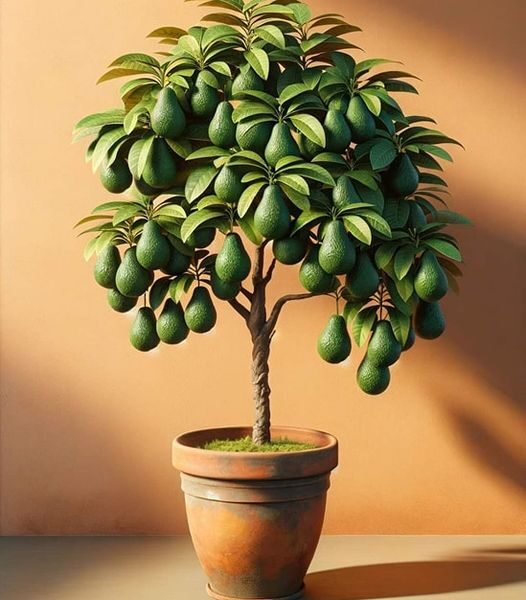How to Grow Avocado in Pots: A Complete Guide
Growing avocado trees in pots is an excellent way to enjoy fresh, home-grown avocados even if you don’t have a large garden or outdoor space. It’s not just a fun project, but also a rewarding one. In this guide, we’ll walk you through the steps to successfully grow avocado trees in pots and ensure they thrive.
1. Choose the Right Variety
Avocados are typically grown from seeds or young saplings, but the type of avocado you choose can make a difference in how well it grows in a pot. Some varieties are better suited for container growth than others. The most popular varieties for container growing include:
- Mexican Avocado (Persea americana var. drymifolia) – This variety is smaller and more suited to pots due to its compact size.
- Guatemalan Avocado (Persea americana var. guatemalensis) – Known for its hardiness and high-quality fruit, it can grow well in containers with proper care.
If you start with a seed, keep in mind that it will take a few years before the tree begins to produce fruit (usually around 5-13 years), whereas purchasing a young tree can yield quicker results.
2. Selecting the Right Pot
Choosing the right pot is crucial for the success of your avocado tree. Here are some key points to consider:
- Size: The pot should be large enough to accommodate the roots. Start with a 10-15 gallon pot, and make sure it has drainage holes to prevent root rot.
- Material: Choose a pot made of lightweight, breathable material like plastic or terracotta. This will help with water drainage and root health.
- Depth: Avocado trees have deep root systems, so the pot should be deep enough to allow for growth.
3. Planting Your Avocado Tree
- Seed: If you are starting with an avocado seed, wash the seed thoroughly and place it in water, with the pointy side up and the flat side submerged, using toothpicks to suspend it over a glass of water. Once the seed begins to sprout roots and a stem, it’s ready to be planted in the pot. Fill the pot with a high-quality, well-draining potting mix, leaving space for the seed or sapling.
- Young Sapling: If you are purchasing a sapling, gently remove it from its nursery pot and place it into your chosen pot. Add soil around the roots and water thoroughly. Make sure the root ball is level with the soil surface.
4. Watering and Soil Care
Avocados prefer well-drained soil, so it’s essential to ensure the potting mix is light and airy. Water your avocado tree regularly, but don’t overwater it. Avocados don’t like “wet feet” (standing water around the roots), so always allow the soil to dry out slightly between waterings.
- Watering: Water when the top 1-2 inches of soil feels dry. Ensure the water drains well from the bottom of the pot.
- Soil: Use a potting mix designed for tropical or citrus plants, or mix your own with equal parts of perlite, sand, and compost to encourage drainage.
5. Light Requirements
Avocados need plenty of light to thrive. Place your pot in a location that gets full sun for at least 6 hours per day. If you are growing indoors, make sure to place the pot by a south-facing window or invest in grow lights. The more sunlight your avocado tree receives, the better the chances of it growing healthy and producing fruit.
6. Temperature and Humidity
Avocado trees love warmth and humidity. They grow best in temperatures between 60°F and 85°F (15°C to 29°C). If you live in a cooler climate, consider bringing your tree inside during the winter months, especially if temperatures drop below 50°F (10°C).
To keep the air around your avocado tree humid, you can mist the leaves occasionally or place a humidifier nearby. A humidity level between 40-60% is ideal for healthy growth.
7. Pruning and Maintenance
Regular pruning helps maintain the shape of your avocado tree and promotes healthy growth. Prune the tree to remove dead or damaged leaves and to control the size, especially if it starts to outgrow its pot. You can also trim back the top to encourage bushier growth.
8. Fertilization
Avocados are heavy feeders and require regular nutrients. Use a balanced fertilizer every 4-6 weeks during the growing season (spring and summer). A fertilizer rich in nitrogen, potassium, and magnesium will help the tree grow healthy leaves and fruit.
9. Pollination and Fruit Production
If your avocado tree is indoors, it may not get the benefit of cross-pollination, which can limit fruit production. Avocado trees are self-pollinating, but they produce two types of flowers (A and B), which open at different times of the day. To encourage fruiting, you may need to plant more than one tree or hand-pollinate by transferring pollen between flowers with a small brush.
In general, even with optimal care, it may take 3-4 years for a young avocado tree to produce fruit in a pot, and longer if grown from seed.
10. Repotting
As your avocado tree grows, it will need to be repotted into a larger container. Repot every 1-2 years to ensure the roots have enough space to grow. When repotting, make sure to use fresh, well-draining potting mix and check the roots for any signs of disease.
Conclusion
Growing an avocado tree in a pot is a fun and rewarding project, offering both a touch of greenery and the prospect of home-grown fruit. With proper care, attention to watering, lighting, and regular maintenance, you can enjoy your own avocado harvest in a few years.
If you found this guide helpful, don’t forget to like and share it with your friends and family! Let’s spread the joy of growing avocados at home!
